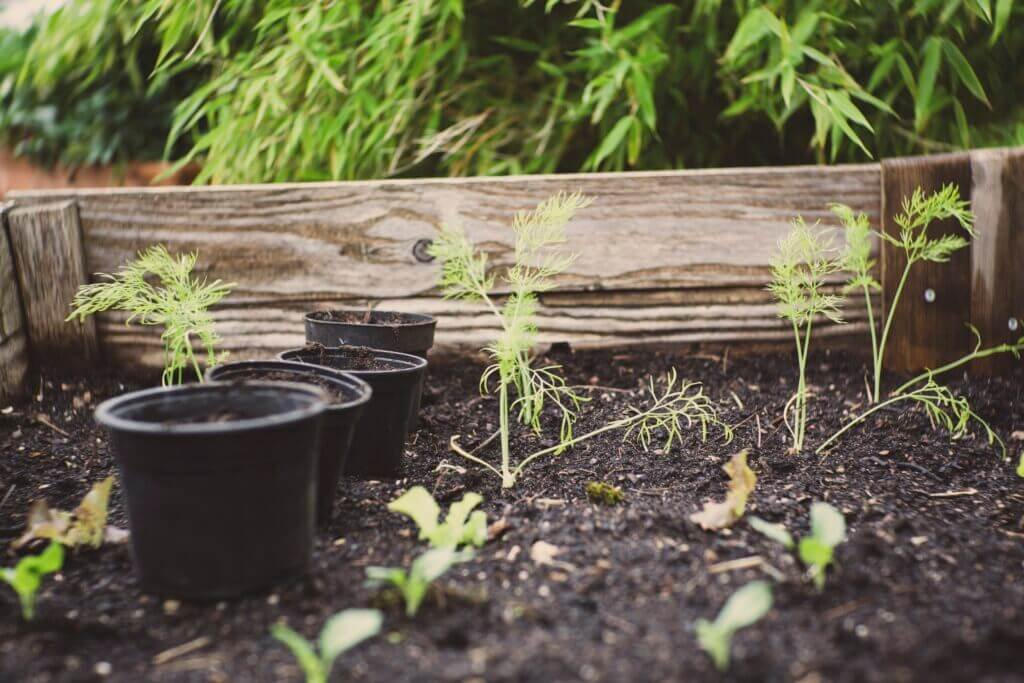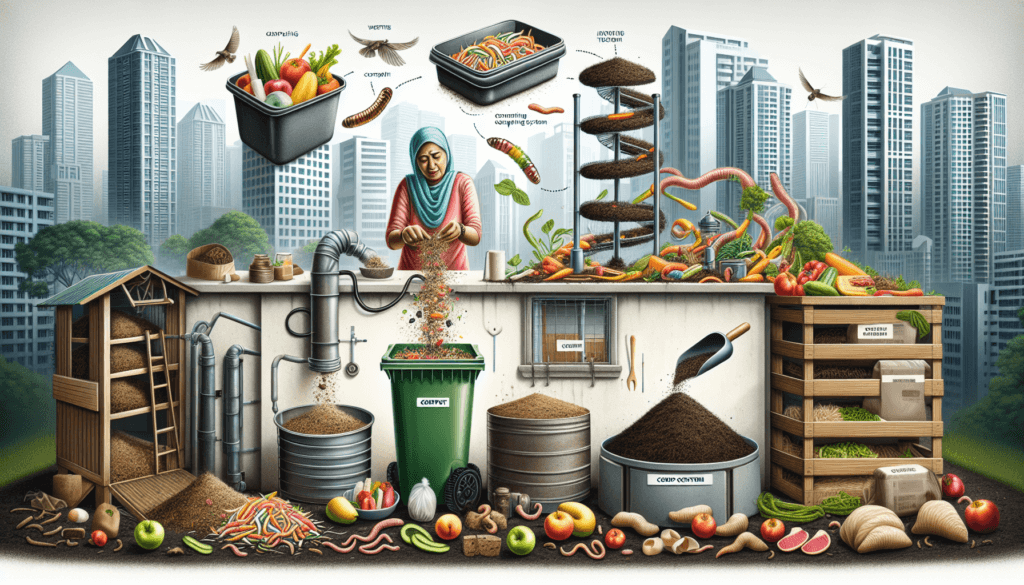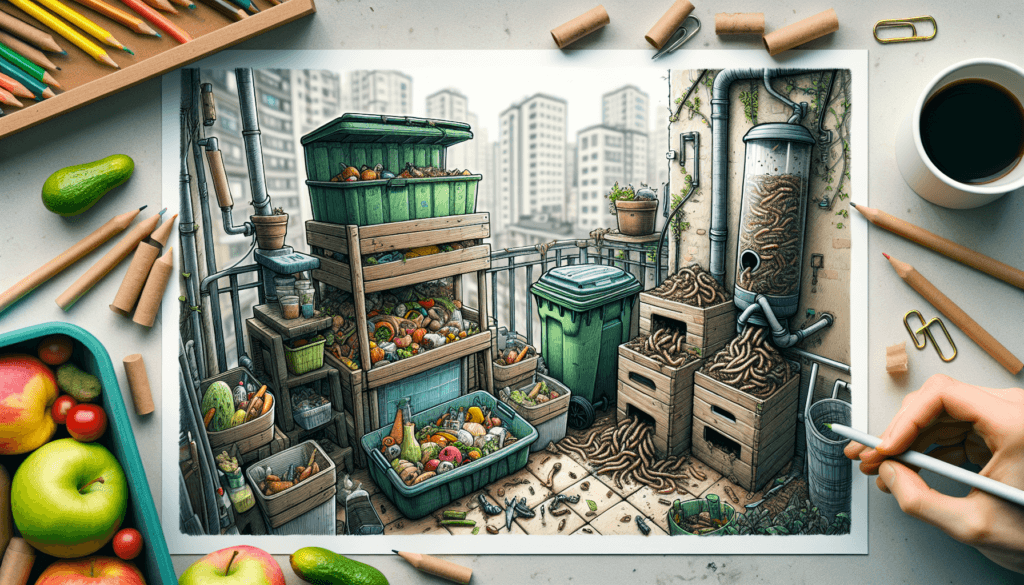Living in a small urban space doesn’t mean you have to miss out on the joys and benefits of composting. With limited outdoor space, finding the best ways to compost can seem challenging, but fear not! In this article, we will explore some ingenious methods that will allow you to compost effectively in tight quarters. From kitchen scrap bins to worm composting, these innovative solutions will help you turn your organic waste into nutrient-rich soil without taking up too much space. So get ready to discover the best ways to compost and reap the rewards of sustainable living, even in the concrete jungle!

Choosing the Right Composting Method
When it comes to composting in a small urban space, there are several factors to consider. Limited space, available resources, and desired composting speed all play a role in choosing the right method for you.
Consideration for limited space
One of the primary challenges in small urban spaces is the limited amount of available space for composting. Traditional composting methods like open-air piles or large compost bins may not be feasible in these situations. However, there are several composting methods specifically designed to fit into tight spaces.
Assessing the available resources
Another important consideration is the availability of resources for composting. This includes materials for composting, such as food scraps, yard waste, or other organic matter. Depending on your location and access to green spaces, you may have different options for sourcing these materials.
Determining the desired composting speed
The speed at which you want your compost to be ready is another factor to consider. Some methods of composting take longer than others, so it’s important to determine how quickly you need usable compost for your gardening or other projects.
1. Vermicomposting
Introduction to vermicomposting
Vermicomposting, also known as worm composting, is a popular method for composting in small urban spaces. It involves the use of specific types of worms, such as red wigglers, to break down organic matter into nutrient-rich compost.
Setting up a worm bin
To start vermicomposting, you’ll need to set up a worm bin. This can be done using a variety of containers, such as a plastic tub or a wooden box. The bin should have proper ventilation, drainage, and bedding material to create a suitable environment for the worms.
Selecting the right type of worms
Not all worms are suitable for vermicomposting. Red wigglers, Eisenia fetida, are the most commonly used worms for this purpose. These worms are highly efficient at breaking down organic matter and can tolerate the confined space of a worm bin.
Feeding and maintaining the worm bin
The key to successful vermicomposting is proper feeding and maintenance of the worm bin. The worms need a balanced diet of food scraps, coffee grounds, leafy greens, and other organic matter. It’s important to avoid feeding them acidic or oily foods, as well as meat or dairy products.
Harvesting and using the vermicompost
When the organic matter in the worm bin has been fully decomposed by the worms, it’s time to harvest the vermicompost. This can be done by separating the worms from the compost using a simple technique called “worm migration.” The vermicompost can then be used as a nutrient-rich soil amendment in your garden, potted plants, or indoor plants.

2. Bokashi Composting
Understanding the bokashi composting process
Bokashi composting is a method that utilizes beneficial microbes to ferment organic waste. It involves the use of a special composting system that allows anaerobic fermentation to take place.
Preparing the bokashi composting system
To start bokashi composting, you’ll need a bokashi composting system, which typically consists of an airtight bin, bokashi composting bran, and a spigot for liquid collection. The system can be set up indoors or outdoors, making it suitable for small urban spaces.
Using the bokashi composting system
To begin the bokashi composting process, add a layer of organic waste to the bin, followed by a sprinkle of bokashi composting bran. Repeat this layering process until the bin is full. During this time, it’s important to press down the waste to ensure it’s fully compacted.
Finalizing the bokashi composting process
Once the bin is full, seal it tightly and allow the anaerobic fermentation process to take place. This typically takes around two weeks, during which time the waste will break down and a liquid called bokashi juice will be produced. After the fermentation period, the bokashi waste can be buried in soil or added to a traditional compost bin to complete the decomposition process.
3. Tumbling Composters
Exploring the benefits of tumbling composters
Tumbling composters offer several advantages for small urban spaces. These composting systems consist of a rotating drum or container that allows for easy turning and aeration of the compost. The tumbling action accelerates the decomposition process and helps reduce odors and pests.
Choosing the right size and design
When selecting a tumbling composter, it’s important to consider the available space and your composting needs. Compact models are available for small urban spaces, and some tumbling composters even have dual chambers, allowing for continuous composting.
Preparing and loading the composter
To begin using a tumbling composter, ensure that it’s properly assembled and located in a convenient spot. Start by adding a mix of green and brown compost materials to the chamber, ensuring a good balance of nitrogen-rich and carbon-rich materials. Remember to chop or shred larger materials to speed up the decomposition process.
Monitoring and maintaining the composter
Regular monitoring and maintenance are crucial for successful composting with a tumbling composter. Turn the drum regularly to ensure proper aeration, which promotes decomposition and prevents odors. Check the moisture levels and add water or dry materials as needed to maintain the ideal moisture content for composting.
Harvesting and using the compost
Once the compost in the tumbling composter has undergone the decomposition process, it’s time to harvest and use it. Simply open the door or lid of the composter and remove the finished compost. The compost can be used in gardens, potted plants, or as a natural fertilizer for indoor or outdoor plants.

4. Composting in Small Spaces without Outdoor Areas
Indoor composting options
For those without access to outdoor areas, indoor composting is a viable solution. There are several options available for composting indoors, including vermicomposting and bokashi composting, which have already been discussed. However, there are other methods that can be used specifically for indoor composting.
Using composting bins or containers
Indoor composting bins or containers are specifically designed to fit into small spaces and control odors. These bins are usually equipped with odor-absorbing filters and airtight lids to minimize any unpleasant smells. They can be placed in kitchens, under sinks, or in other convenient areas.
Composting with pet waste
If you have pets, you can also compost their waste indoors. Special composting systems designed for pet waste, such as doggie septic systems or cat toilet training systems, can be used to safely compost and dispose of pet waste without the need for an outdoor area.
Utilizing indoor composting systems
There are also compact indoor composting systems available that use various techniques like heat, microbes, or accelerators to break down organic waste quickly. These systems are often self-contained and require minimal maintenance, making them ideal for small urban spaces without outdoor areas.
5. Small-Scale Backyard Composting
Selecting the right composting method
If you have a small backyard or outdoor area available, there are several composting methods that can be utilized. The choice of method will depend on your space, resources, and desired composting speed. Consider options such as vermicomposting, traditional compost bins, or tumbling composters.
Building or purchasing a compost bin
To start small-scale backyard composting, you’ll need a compost bin. This can be built using materials like wood or wire mesh, or purchased from hardware stores or garden centers. Ensure the bin is sturdy, well-ventilated, and has a lid to control pests and odors.
Layering compost materials effectively
To effectively compost in a small backyard, it’s important to layer your compost materials correctly. Alternate layers of green waste (such as fruit and vegetable scraps or grass clippings) with brown waste (such as leaves or shredded paper). This will provide a good balance of nitrogen and carbon for efficient composting.
Maintaining the compost pile
Regular maintenance is essential for successful backyard composting. Turn the pile regularly to ensure proper aeration and decomposition. Monitor the moisture levels and add water or dry materials as needed. Avoid adding meat, dairy, or oily foods that can attract pests and create unpleasant odors.
Harvesting and using the compost
Once your compost has fully decomposed, it’s ready to be harvested and used in your garden. Use a garden fork or shovel to remove the compost from the bottom of the pile. Apply the compost to your plants, gardens, or potted plants to provide them with valuable nutrients and improve soil health.

6. Apartment and Balcony Composting
Introduction to apartment and balcony composting
Living in an apartment or having a small balcony doesn’t mean you can’t compost. There are several options available specifically designed for apartment and balcony composting. These methods are compact, odor-free, and suitable for smaller spaces.
Using composting bins or containers
Composting bins or containers are ideal for apartment and balcony composting. They come in various sizes and designs to fit different spaces. Look for bins or containers specifically designed for small-scale composting, such as stackable bins or those with built-in odor control systems.
Utilizing composting tumbler or composter
Composting tumblers or composters are also suitable for apartment and balcony composting. These compact systems allow for easy composting and can be placed on balconies or in other small outdoor areas. Look for models that have a tight seal to prevent odor leakage and pest entry.
Maximizing space through vertical composting
In apartment or balcony composting, space is often limited. Vertical composting is a great solution to maximize the available space. Vertical composting systems, such as worm towers or stacked composters, allow for efficient composting while taking up minimal floor or ground space.
Tips for odor control and pest management
To ensure a pleasant composting experience in small urban spaces, it’s important to control odors and manage pests effectively. Use compost bins or containers with odor-absorbing filters or add a layer of dry leaves or shredded newspaper on top of the compost to control odors. Regularly monitor the compost for pests and implement necessary measures to prevent infestations.
7. Community Composting
Joining or starting a community composting initiative
Community composting is an excellent option for those living in small urban spaces without the ability to compost individually. Joining or starting a community composting initiative allows individuals to come together and collectively compost their organic waste.
Finding suitable locations for community composting
When starting or joining a community composting initiative, it’s important to find suitable locations for composting. This can include community gardens, parks, or unused spaces that can be converted into composting areas. Consider factors such as accessibility, convenience, and proximity to participating households.
Organizing compost collection and management
Effective organization is essential for successful community composting. Establish a system for collecting organic waste from participating households and transporting it to the composting site. Ensure that all members are aware of the guidelines for what can and cannot be composted to avoid contamination.
Benefits of community composting
Community composting offers numerous benefits for small urban spaces. It reduces the amount of organic waste going to landfills, creates nutrient-rich compost for community gardens or shared green spaces, and builds a sense of community and shared responsibility for sustainability.

8. Small-Scale Composting Tools and Accessories
Introduction to composting tools and accessories
To facilitate efficient and successful composting in small urban spaces, there are various tools and accessories available. These tools can help you monitor and maintain your compost, improve aeration, and enhance the overall composting process.
Mini compost bins and containers
Mini compost bins or containers are designed specifically for small-scale composting. They are compact and can be easily placed on countertops or in tight spaces. These bins often come with a charcoal filter to control odors and prevent fruit flies from entering.
Compost thermometer and moisture meters
A compost thermometer is an essential tool for monitoring the temperature of your compost pile. Different microorganisms thrive at different temperatures, so monitoring the temperature can help ensure optimal decomposition. Moisture meters, on the other hand, help you gauge the moisture levels in your compost and prevent it from becoming too dry or too wet.
Aeration and turning tools
Proper aeration is crucial for efficient composting. Aeration tools, such as compost aerators or hand forks, help you turn and mix your compost pile, ensuring oxygen is distributed evenly. This promotes decomposition and prevents the pile from becoming compacted.
Kitchen scrap collectors
To easily collect kitchen scraps for composting, consider using kitchen scrap collectors. These can be small containers with tight-sealing lids that can be kept on countertops or under sinks. Some collectors even have carbon filters to control odors.
10. Utilizing Compost in Small Urban Spaces
Integrating compost into container gardening
Container gardening offers a great opportunity to utilize compost in small urban spaces. Use compost as a soil amendment when planting flowers, vegetables, or herbs in containers. Mix compost with potting soil to provide essential nutrients and improve soil structure for healthy plant growth.
Applying compost to indoor plants
Indoor plants also benefit from the use of compost. Incorporate compost into the potting mix when repotting plants or use it as a topdressing for existing plants. Compost provides essential nutrients and improves water retention, promoting healthy growth and reducing the need for synthetic fertilizers.
Topdressing lawns and small outdoor spaces
If you have a small lawn or outdoor space, compost can be used as a topdressing to promote healthy grass growth. Apply a thin layer of compost evenly over the lawn and water it thoroughly. The compost will gradually release nutrients into the soil, improving soil health and enhancing the appearance of your outdoor space.
Mixing compost in potting soil for houseplants
For houseplants, incorporate compost into the potting soil to enhance their growth and overall health. Use a mixture of compost, potting soil, and other amendments like perlite or vermiculite for optimal drainage and aeration. The compost will provide essential nutrients and organic matter to support healthy root development and plant growth.
In conclusion, composting in a small urban space is not only possible but also beneficial. By choosing the right composting method, assessing available resources, and considering composting speed, you can successfully compost in limited spaces such as apartments, balconies, or small backyards. Whether you opt for vermicomposting, bokashi composting, tumbling composters, or other techniques, the resulting compost can be used to enrich your plants, gardens, and local community. Happy composting!

